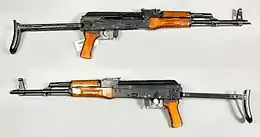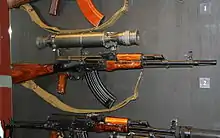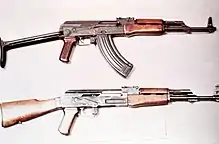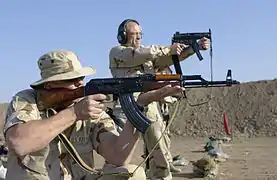AKM
The AKM (Russian: Автома́т Кала́шникова модернизи́рованный, tr. Avtomát Kalášnikova modernizírovannyj, lit. 'Kalashnikov's Automatic Rifle Modernised') is a 7.62×39mm assault rifle designed by Mikhail Kalashnikov. It is a common modernised variant of the AK-47 rifle developed in the 1940s.
| AKM | |
|---|---|
 AKM from the collections of the Swedish Army Museum | |
| Type | Assault rifle |
| Place of origin | Soviet Union |
| Service history | |
| In service | 1959–present |
| Used by | See Users below |
| Wars | See Conflicts below |
| Production history | |
| Designer | Mikhail Kalashnikov |
| Designed | 1950s |
| Manufacturer |
|
| Produced | 1959–1977[1] (Soviet Union) |
| No. built | More than 10,278,300 |
| Variants | See Variants |
| Specifications (Updated information) | |
| Mass |
|
| Length |
|
| Barrel length | 415 mm (16.3 in)[2] |
| Cartridge | 7.62×39mm M43 |
| Caliber | 7.62mm |
| Action | Gas operated, rotating bolt |
| Rate of fire | |
| Muzzle velocity | 715 m/s (2,346 ft/s)[2] |
| Effective firing range | 350 m (383 yd)[2] |
| Feed system | 10-, 20-, or 30-round detachable box magazines. Also compatible with 40-round box magazines and 75-round drum magazines from the RPK |
| Sights |
|
Introduced into service with the Soviet Army in 1959, the AKM is the prevalent variant of the entire AK series of firearms and it has found widespread use with most member states of the former Warsaw Pact and its African and Asian allies as well as being widely exported and produced in many other countries. The production of these rifles was carried out at both the Tula Arms Plant and Izhmash. It was officially replaced in Soviet frontline service by the AK-74 in the late 1970s, but remains in use worldwide.
The AKM maintains the AK-47's wood stock, but has simpler individual parts that are favorable for mass production. Like the AK-47, many variants of the AKM exist such as the AKMS, AKML, and AKMP.
Design details
The AKM is an assault rifle chambered in 7.62×39mm Soviet intermediate cartridge. It is a selective fire, gas operated with a rotating bolt, firing in either semi-automatic or fully automatic, and has a cyclic rate of fire of around 600 rounds per minute (RPM). The gas operated action has a massive bolt carrier with a permanently attached long stroke gas piston. The gas chamber is located above the barrel. The bolt carrier rides on the two rails, formed on the side of the receiver, with a significant space between the moving and stationary parts.[3] Despite being replaced in the late 1970s by the AK-74, the AKM is still in service in some Russian Army reserve and second-line units and several east European countries. The GRAU officially designated the AKM as the 6P1 assault rifle.
Improvements over AK-47

Compared with the AK-47, the AKM features detail improvements and enhancements that optimized the rifle for mass production; some parts and assemblies were conceived using simplified manufacturing methods. Notably, the AK-47's milled steel receiver was replaced by a U-shaped steel stamping. As a result of these modifications, the AKM's weight was reduced by ≈ 1 kg (2.2 lb), the accuracy during automatic fire was increased and several reliability issues were addressed. The AK-47's chrome-lined barrel was retained, a common feature of Soviet weapons which resists wear and corrosion, particularly under harsh field conditions and near-universal Eastern Bloc use of corrosively primed ammunition.
The AKM's receiver is stamped from a smooth 1.0 mm (0.04 in) sheet of steel, compared with the AK-47 where the receiver was machined from heavier gauge steel. A rear stock trunnion and forward barrel trunnion are fastened to the U-shaped receiver using rivets. The receiver housing also features a rigid tubular cross-section support that adds structural strength. Guide rails that assist the bolt carrier's movement which also incorporates the ejector are installed inside the receiver through spot welding. As a weight-saving measure, the stamped receiver cover is of thinner gauge metal than that of the AK-47. In order to maintain strength and durability it employs both longitudinal and latitudinal reinforcing ribs.
Barrel
The AKM has a barrel with a chrome-lined bore and four right-hand grooves at a 240 mm (1 in 9.45 in) or 31.5 calibers rifling twist rate. The forward barrel trunnion has a non-threaded socket for the barrel and a transverse hole for a pin that secures the barrel in place. The AKM's barrel is installed in the forward trunnion and pinned (as opposed to the AK-47, which has a one piece receiver with integral trunnions and a barrel that is screwed-in). Additionally the barrel has horizontal guide slots that help align and secure the handguards in place. To increase the weapon's accuracy during automatic fire, the AKM was fitted with a slant cut compensator that helps redirect expanding propellant gases upward and to the right during firing, which mitigates the rise of the muzzle during an automatic burst when held by a right-handed firer. The compensator is threaded on to the end of the barrel with a left-hand thread. Not all AKMs have slant compensators; some were also fitted with the older muzzle nut which came from the AK-47. Most AKMs with muzzle nuts were older production models. The AKM's slant compensator can also be used on the AK-47, which had a simple nut to cover the threads.
Gas block
The gas block in the AKM does not have a cleaning rod capture or sling loop but is instead fitted with an integrated bayonet support collar that has a cleaning rod guide hole. The forward sling loop was relocated to the front handguard retainer cap. The handguard retainer also has notches that determine the position of the handguards on the barrel. The AKM's laminated wood handguards have lateral grooves that help securely grip the rifle.
Gas relief ports that alleviate gas pressure in the piston cylinder (placed horizontally in a row on the gas cylinder in the AK-47) were moved forward to the gas block and placed in a radial arrangement.
Bolt carrier assembly
The AKM's bolt carrier has a lightening cut milled into the right side halfway before the handle. The handle has its profile slimmed down too. The stem of the AKM bolt is fluted in another measure to help reduce weight. The round, fluted firing pin of the AK-47 was also replaced with a flat one on the AKM. All pieces are typically blued instead of left "in the white".[4][5][6]
Stock

The buttstock, lower handguard and upper heatguard are manufactured from birch plywood laminates like the later model AK-47 furniture.[7] Such engineered woods are stronger and resist warping better than the conventional one-piece patterns, do not require lengthy maturing, and are cheaper. The wooden buttstock used in the AKM is further hollowed in order to reduce weight and is longer and straighter than that of the AK-47, which assists accuracy for subsequent shots during rapid and automatic fire. The wooden stock also houses the issued cleaning kit, which is a small diameter metal tube with a twist lock cap. The kit normally contains the cleaning jag to which a piece of cloth material is wrapped around and dipped into cleaning solution. It also contains a pin punch, an assembly pin to hold the trigger, disconnector and rate reducer together while putting these back into the receiver after cleaning the weapon, and a barrel brush. The kit is secured inside the butt stock via a spring-loaded trapdoor in the stock's pressed sheet metal butt cap. The stock is socketed into a stepped shaped rear trunnion with single upper tang and two screws. The rear trunnion itself is held to the stamped receiver with four rivets (two on each side). Under folding models instead have a U-shaped rear trunnion that reinforces the locking arms and is held to the receiver with six rivets (see Variants for more info).
Recoil/return spring assembly
The AKM uses a modified recoil/return spring mechanism, which replaces the telescoping recoil spring guide rod with a dual "U"-shaped wire guide.
Trigger assembly
The AKM has a modified trigger assembly, equipped with a hammer-release delaying device (installed on the same axis pin together with the trigger and disconnector) commonly called a "rate reducer" or "hammer retarder" (Russian: замедлитель срабатывания курка). In fact its primary purpose is not to reduce the rate of automatic fire; it is a safety device to ensure the weapon will only fire on automatic when the bolt is fully locked, as the hammer is tripped by the bolt carrier's last few millimetres of forward movement. The device also reduces "trigger slap" or "trigger bounce" and the weapon's rate of fire, which also reduces the dispersion of bullets when firing in fully automatic mode. The hammer was also changed and equipped with a protrusion that engages the rate reducer and the trigger has only one notched hammer release arm (compared with two parallel arms in the AK-47).[8][9]
Sights
The AKM's notched rear tangent iron sight is calibrated in 100 m (109 yd) increments from 100 to 1,000 m (109 to 1,094 yd) and compared with the AK-47 the leaf's position teeth that secure the sliding adjustable notch were transferred over from the right to the left edge of the ramp. The front sight is a post adjustable for elevation in the field and has a slightly different shape with the "ears" being angled with the back of the base instead of strait and its bottom portion is more narrow compared with the AK-47. Horizontal adjustment requires a special drift tool and is done by the armoury before issue or if the need arises by an armourer after issue. The sight line elements are approximately 48.5 mm (1.9 in) over the bore axis. The "point-blank range" battle zero setting "П" on the 7.62×39mm AKM rear tangent sight element corresponds to a 300 m (328 yd) zero.[10] For the AKM combined with service cartridges the 300 m battle zero setting limits the apparent "bullet rise" within approximately −5 to +31 cm (−2.0 to 12.2 in) relative to the line of sight. Soldiers are instructed to fire at any target within this range by simply placing the sights on the center of mass (the belt buckle, according to Russian and former Soviet doctrine) of the enemy target. Any errors in range estimation are tactically irrelevant, as a well-aimed shot will hit the torso of the enemy soldier.[10]
Magazines
.jpg.webp)
The early slab-sided steel AK-47 30-round detachable box magazines had 1 mm (0.039 in) sheet-metal bodies and weigh 0.43 kg (0.95 lb) empty.[11] The later steel AKM 30-round magazines had lighter sheet-metal bodies with prominent reinforcing ribs weighing 0.33 kg (0.73 lb) empty.[11][12] To further reduce weight a light weight magazine with an aluminium body with a prominent reinforcing waffle rib pattern weighing 0.19 kg (0.42 lb) empty was developed for the AKM that proved to be too fragile and the small issued amount of these magazines were quickly withdrawn from service.[13] As a replacement steel-reinforced 30-round plastic 7.62×39mm box magazines were introduced. These rust-coloured magazines weigh 0.24 kg (0.53 lb) empty and are often mistakenly identified as being made of Bakelite (a phenolic resin), but were actually fabricated from two-parts of AG-S4 moulding compound (a glass-reinforced phenol-formaldehyde binder impregnated composite), assembled using an epoxy resin adhesive.[14][15][16][17] Noted for their durability, these magazines did, however, compromise the rifle's camouflage and lacked the small horizontal reinforcing ribs running down both sides of the magazine body near the front that were added on all later plastic magazine generations.[17] A second generation steel-reinforced dark-brown (colour shades vary from maroon to plum to near black) 30-round 7.62×39mm magazine was introduced in the early 1980s, fabricated from ABS plastic. The third generation steel-reinforced 30-round 7.62×39mm magazine is similar to the second generation, but is darker coloured and has a matte non-reflective surface finish. The current issue steel-reinforced matte true black non-reflective surface finished 7.62×39mm 30-round magazines, fabricated from ABS plastic weigh 0.25 kg (0.55 lb) empty.[18] Early steel AK-47 magazines are 9.75 in (248 mm) long, and the later ribbed steel AKM and newer plastic 7.62×39mm magazines are about 1 in (25 mm) shorter.[19][20]
The transition from steel to mainly plastic magazines yielded a significant weight reduction and allow a soldier to carry more rounds for the same weight.
| Rifle | Cartridge | Cartridge weight | Weight of empty magazine | Weight of loaded magazine | Max. 10.12 kg (22.3 lb) ammunition load* |
|---|---|---|---|---|---|
| AK-47 (1949) | 7.62×39mm | 16.3 g (252 gr) | slab-sided steel 430 g (0.95 lb) |
30-rounds 916 g (2.019 lb)[21] |
11 magazines for 330 rounds 10.08 kg (22.2 lb) |
| AKM (1959) | 7.62×39mm | 16.3 g (252 gr) | ribbed stamped-steel 330 g (0.73 lb) |
30-rounds 819 g (1.806 lb)[12][22] |
12 magazines for 360 rounds 9.83 kg (21.7 lb) |
| AK-103 (1994) | 7.62×39mm | 16.3 g (252 gr) | steel-reinforced plastic 250 g (0.55 lb) |
30-rounds 739 g (1.629 lb)[12][22] |
13 magazines for 390 rounds 9.61 kg (21.2 lb) |
Note: All 7.62×39mm AK magazines are backwards compatible with older AK variants.
*10.12 kg (22.3 lb) is the maximum amount of ammo that the average soldier can comfortably carry. It also allows for best comparison of the three most common 7.62×39mm AK-style magazines.
Accessories

.JPG.webp)
The AKM comes supplied with a different accessory kit that contains a M1959 6H4 or 6H3-type bayonet and comes with synthetic or steel magazines. Both the 6H3 and 6H4 bayonet blade forms a wire-cutting device when coupled with its scabbard. The polymer grip and upper part of the scabbard provide insulation from the metal blade and bottom part of the metal scabbard, using a rubber insulator sleeve, to safely cut electrified wire. The kit also comes with a punch used to drive out various pins and a device that aids in assembling the rate reducing mechanism. The GP-25 Grenade launcher can also be fitted onto the AKM. There is also the PBS-1 silencer from the 1960s, designed to reduce the noise when firing, mostly used by Spetsnaz forces and the KGB.
Ammunition
The weapon uses the same ammunition as the AK-47: the 7.62×39mm M43 intermediate rifle cartridge. The AKM mechanism's design principles and procedures for loading and firing are practically identical to those of the AK-47, the only difference being the trigger assembly (during the return stage of the bolt carrier on fully automatic mode) as a result of incorporating the rate reducer device.
Variants





The main variant of the AKM is the AKMS (S – Skladnoy – Folding), which was equipped with an under-folding metal shoulder stock in place of the fixed wooden stock. The metal stock of the AKMS is somewhat different from the folding stock of the previous AKS-47 model as it has a modified locking mechanism, which locks both support arms of the AKMS stock instead of just one (left arm) as in the AKS-47 folding model. It is also made of riveted steel pressings, instead of the milled versions of most AKS-47s, and is more inline like the fixed stock AKM. Due to the stamped receiver, it also has a reinforcement plate beneath the pistol grip spot welded in place to prevent damage to the receiver if the gun is dropped on its pistol grip as well as better absorb the recoil with the stock folded.
The AKM was produced in the following versions: AKMP, AKML and AKMLP, whereas the AKMS led to the following models – AKMSP, AKMSN and AKMSNP. It is designed especially for use by paratroopers–as the folding stock permits more space for other equipment when jumping from a plane and then landing.
The AKMP rifle uses subdued Radium-illuminated aiming points integrated into the front and rear sight. These sights enable targets to be engaged in low-light conditions, e.g. when the battlefield is illuminated with flares, fires or muzzle flashes or when the target is visible as a shadow against an illuminated background. The sliding notch on the sight arm is then moved to the “S” setting (which corresponds to the “3” setting in the AKM). The sight itself is guided on the sliding scale and has a socket, which contains a tritium gas-filled capsule directly beneath the day-time notch. The tritium front post installs into the front sight base using a detent and spring.
The AKML comes equipped with a side-rail used to attach a night vision device. The mount comprises a flat plate riveted to the left wall of the receiver housing and a support bracket fixed to the mounting base with screws. To shield the light-sensitive photo detector plate of the night vision sight, the weapon uses a slotted flash suppressor, which replaces the standard recoil compensator. The AKML can also be deployed in the prone position with a detachable barrel-mounted bipod that helps stabilise the weapon and reduces operator fatigue during prolonged periods of observation. The bipod is supplied as an accessory and is carried in a holster attached to the duty belt.
The AKMN comes equipped with a side-rail used to attach a night vision device. The model designated AKMN-1 can thus mount the multi-model night vision scope 1PN51[23] and the AKMN2 the multi-model night vision scope 1PN58.[24]
The AKMLP is a version of the AKML with tritium sights (as in the AKMP).
The AKMSP rifle is based on the folding stock AKMS variant but fitted with tritium night sights, as in the AKMP.
The AKMSN model is derived from the AKMS and features an accessory rail used to mount a night vision sensor as seen on the AKML and additionally a flash hider and bipod. The left arm of the AKMSN's folding stock is bent outwards in order to avoid the sight mount bracket during folding and the sling loop was moved further to the rear. Similarly to the AKMN-1, the AKMSN-1 can mount the multi-model night vision scope 1PN51[23] and the AKMSN2 the multi-model night vision scope 1PN58.[24]
A version of the AKMSN additionally supplied with factory tritium night sights is called the AKMSNP.
A version of the AKM with a modified lower handguard designed to accept the 40 mm wz. 1974 Pallad grenade launcher was developed in Poland and designated the karabinek-granatnik wz. 1974.
Peru
Diseños Casanave International LLC has made an upgraded version of the AKM known as the Diseños Casanave International LLC SC-2026, which has a retractable polycarbonate stock and a railed handguard.[25] It has a range of 400 meters and weights less than 4 kilograms.[25]
DICI also makes the Diseños Casanave International LLC SC-2026C, a carbine version of the SC-2026 made for vehicle crews/personnel and for special forces operators.[25]
Vietnam
The STL-1A is made by Z111 Factory as early as 2015 by changing parts of used AKMs with new plastic handguards, folding buttstock, ergonomic pistol grip and updated muzzle brake resembling the AK-74 with an attachment lug for use with a M203 grenade launcher known as the STL-1A.[26][27] A future upgrade, known as the STL-1B, will include Picatinny rails since the 1A uses a side-type attachment.[27]
Vietnam also makes AKM-1, a AKM version which has replaced wood stock and hand guards with Polyamide made, implemented Soviet style optics mounting rail.
Semi-automatic only variant
The WASR-10 is a semi-automatic only variant developed from the AKM series rifle but is not another version rather a derivative or variant due to significant changes. The lack of the dimple over the magazine well is a peculiar WASR feature helpful in identification of WASR series rifles.[28]
The WASR series are manufactured in Romania by the arms-maker Cugir and widely imported into the United States for the sporting gun market by importer Century International Arms who modifies them with TAPCO stocks.[29] Century began installing the TAPCO Intrafuse AK G2 trigger group in 2007 to eliminate bolt slap trigger finger injuries.[30]
Gallery
 A right-side and left-side view of the AKM.
A right-side and left-side view of the AKM. An Iranian child soldier holding an AKM in the Iran–Iraq War.
An Iranian child soldier holding an AKM in the Iran–Iraq War. A Kbk AKMS fitted with a MILES laser training device in the hands of a Polish soldier in 1997.
A Kbk AKMS fitted with a MILES laser training device in the hands of a Polish soldier in 1997. Foreground: A member of the United States Air Force field-qualifying with a USSR AKM in Iraq.
Foreground: A member of the United States Air Force field-qualifying with a USSR AKM in Iraq. AKM with NSP-3 night sight, and PBS-1 silencer.
AKM with NSP-3 night sight, and PBS-1 silencer..jpg.webp) Gold plated assault rifle built by Tabuk in Iraq to the specifications of the AKMS.
Gold plated assault rifle built by Tabuk in Iraq to the specifications of the AKMS.
Accuracy potential
The following table represents the Russian method for determining accuracy, which is far more complex than Western methods. In the West, one fires a group of shots into the target and then simply measures the overall diameter of the group. The Russians, on the other hand, fire a group of shots into the target. They then draw two circles on the target, one for the maximum vertical dispersion of hits and one for the maximum horizontal dispersion of hits. They then disregard the hits on the outer part of the target and only count half of the hits (50% or R50) on the inner part of the circles. This dramatically reduces the overall diameter of the groups. They then use both the vertical and horizontal measurements of the reduced groups to measure accuracy. This circular error probable method used by the Russian and other European militaries cannot be converted and is not comparable to US military methods for determining rifle accuracy. When the R50 results are doubled the hit probability increases to 93.7%.
| AKM short burst dispersion with 57-N-231 steel core service ammunition[31] | ||||
|---|---|---|---|---|
| Range | Vertical accuracy of fire (R50) | Horizontal accuracy of fire (R50) | Remaining bullet energy | Remaining bullet velocity |
| 0 m (0 yd) | 0 cm (0.0 in) | 0 cm (0.0 in) | 2,036 J (1,502 ft⋅lbf) | 718 m/s (2,356 ft/s) |
| 100 m (109 yd) | 8 cm (3.1 in) | 11 cm (4.3 in) | 1,540 J (1,140 ft⋅lbf) | 624 m/s (2,047 ft/s) |
| 200 m (219 yd) | 15 cm (5.9 in) | 22 cm (8.7 in) | 1,147 J (846 ft⋅lbf) | 539 m/s (1,768 ft/s) |
| 300 m (328 yd) | 23 cm (9.1 in) | 33 cm (13.0 in) | 843 J (622 ft⋅lbf) | 462 m/s (1,516 ft/s) |
| 400 m (437 yd) | 31 cm (12.2 in) | 44 cm (17.3 in) | 618 J (456 ft⋅lbf) | 395 m/s (1,296 ft/s) |
| 500 m (547 yd) | 39 cm (15.4 in) | 56 cm (22.0 in) | 461 J (340 ft⋅lbf) | 342 m/s (1,122 ft/s) |
| 600 m (656 yd) | 47 cm (18.5 in) | 67 cm (26.4 in) | 363 J (268 ft⋅lbf) | 303 m/s (994 ft/s) |
| 700 m (766 yd) | 55 cm (21.7 in) | 78 cm (30.7 in) | 314 J (232 ft⋅lbf) | 282 m/s (925 ft/s) |
| 800 m (875 yd) | 64 cm (25.2 in) | 90 cm (35.4 in) | 284 J (209 ft⋅lbf) | 268 m/s (879 ft/s) |
- R50 means the closest 50 percent of the shot group will all be within a circle of the mentioned diameter.
In general, this is an improvement with respect to firing accuracy to the AK-47. The vertical and horizontal mean (R50) deviations with service ammunition at 800 m (875 yd) for AK platforms are.
| SKS, AK-47, AKM, and AK-74 dispersion at 800 m (875 yd) | |||
|---|---|---|---|
| Rifle | Firing mode | Vertical accuracy of fire (R50) | Horizontal accuracy of fire (R50) |
| SKS (1945) | semi-automatic | 38 cm (15.0 in) | 29 cm (11.4 in) |
| AK-47 (1949) | semi-automatic | 49 cm (19.3 in) | 34 cm (13.4 in) |
| AK-47 (1949) | short burst | 76 cm (29.9 in) | 89 cm (35.0 in) |
| AKM (1959) | short burst | 64 cm (25.2 in) | 90 cm (35.4 in) |
| AK-74 (1974) | short burst | 48 cm (18.9 in) | 64 cm (25.2 in) |
Users




 Afghanistan[32]
Afghanistan[32] Albania[33]
Albania[33] Algeria[33]
Algeria[33] Angola[33]
Angola[33] Armenia[33]
Armenia[33] Azerbaijan[33]
Azerbaijan[33] Bangladesh[33]
Bangladesh[33] Belarus[33]
Belarus[33] Benin[33]
Benin[33] Bosnia-Herzegovina[33]
Bosnia-Herzegovina[33] Botswana[33]
Botswana[33] Bulgaria: Produced locally.[33][34]
Bulgaria: Produced locally.[33][34] Cambodia[33]
Cambodia[33] Cape Verde[33]
Cape Verde[33] Central African Republic[33]
Central African Republic[33] Chad[33]
Chad[33] Chile: Used by Salvador Allende during the 1973 Chilean coup d'état.[35]
Chile: Used by Salvador Allende during the 1973 Chilean coup d'état.[35] China: Type 56 variant.[36]
China: Type 56 variant.[36] Comoros[33]
Comoros[33] Congo-Brazzaville[33]
Congo-Brazzaville[33] Congo-Kinshasa[33]
Congo-Kinshasa[33] Cuba: Produced locally under license.[33] Also used Type 68s in the 1980s.[37]
Cuba: Produced locally under license.[33] Also used Type 68s in the 1980s.[37] Djibouti[32]
Djibouti[32] Egypt: The Maadi is an Egyptian copy of the AKM, manufactured by Factory 54 of the Maadi Company for Engineering Industries in Cairo for the Egyptian Army and for export sales.[38][39][40][41][42]
Egypt: The Maadi is an Egyptian copy of the AKM, manufactured by Factory 54 of the Maadi Company for Engineering Industries in Cairo for the Egyptian Army and for export sales.[38][39][40][41][42] El Salvador: ex-guerilla rifles used by the National Civil Police.[43]
El Salvador: ex-guerilla rifles used by the National Civil Police.[43] Equatorial Guinea[33]
Equatorial Guinea[33] Eritrea[33]
Eritrea[33] Ethiopia[44]
Ethiopia[44] Finland: Holds stocks of imported AKM clones for wartime reserve service (the Chinese Type 56 known as the RK 56 TP and the East German MPi-KM as the RK 72)[45] along with locally designed AK derivatives (the Rk 62 and the Rk 95 TP).
Finland: Holds stocks of imported AKM clones for wartime reserve service (the Chinese Type 56 known as the RK 56 TP and the East German MPi-KM as the RK 72)[45] along with locally designed AK derivatives (the Rk 62 and the Rk 95 TP). France: 100 Polish made AKM rifles obtained for CENTIAL-51e RI training center[46]
France: 100 Polish made AKM rifles obtained for CENTIAL-51e RI training center[46] Gabon[33]
Gabon[33] Georgia[33]
Georgia[33] Ghana: Used by Ministry of Interior units.[47]
Ghana: Used by Ministry of Interior units.[47] Guatemala[48]
Guatemala[48] Guinea[33]
Guinea[33] Guinea-Bissau[33]
Guinea-Bissau[33] Guyana[33]
Guyana[33] Hungary: There is a Hungarian derivative of the AKM called 'AK-63' manufactured by FÉG. The AK-63 comes with a fixed wooden or plastic stock, but there is a version with an under-folding metal stock called AK-63D.[33]
Hungary: There is a Hungarian derivative of the AKM called 'AK-63' manufactured by FÉG. The AK-63 comes with a fixed wooden or plastic stock, but there is a version with an under-folding metal stock called AK-63D.[33] India: Various models of AKM and AKM style rifle in use. A local variant developed and manufactured by the Rifle Factory Ishapore.[33] Recently most of them are being modified and upgraded with Israeli Fab defense accessories
India: Various models of AKM and AKM style rifle in use. A local variant developed and manufactured by the Rifle Factory Ishapore.[33] Recently most of them are being modified and upgraded with Israeli Fab defense accessories Iran: From Chinese manufactures.[33]
Iran: From Chinese manufactures.[33] Iraq: From Soviet, German and Romanian manufactures.[33][49]
Iraq: From Soviet, German and Romanian manufactures.[33][49]
 Israel: Captured from Arab armies over the course of the Arab–Israeli conflict.[33]
Israel: Captured from Arab armies over the course of the Arab–Israeli conflict.[33] Ivory Coast[51]
Ivory Coast[51] Kazakhstan[33]
Kazakhstan[33] Kenya: Kenyan police responding to the 2013 Westgate shopping mall shooting, seen armed with AKM and variant rifles.[52]
Kenya: Kenyan police responding to the 2013 Westgate shopping mall shooting, seen armed with AKM and variant rifles.[52] Kyrgyzstan[53]
Kyrgyzstan[53] Laos[33]
Laos[33] Lesotho[33]
Lesotho[33] Liberia[33]
Liberia[33] Libya[33]
Libya[33] Madagascar[33]
Madagascar[33] Mali: Armed and Security Forces of Mali.[33]
Mali: Armed and Security Forces of Mali.[33] Moldova[33]
Moldova[33] Mongolia[33]
Mongolia[33] Morocco[33]
Morocco[33] Mozambique[33]
Mozambique[33] Nicaragua[54]
Nicaragua[54] Niger[55]
Niger[55] Nigeria[33]
Nigeria[33] North Korea: Type 68 variant.[33] The variant does not have a rate reducer.[56]
North Korea: Type 68 variant.[33] The variant does not have a rate reducer.[56] Panamá:Used by National Border Service (SENAFRONT) and National Aeronaval Service (SENAN).
Panamá:Used by National Border Service (SENAFRONT) and National Aeronaval Service (SENAN). Pakistan: Type 56 variant.[33]
Pakistan: Type 56 variant.[33] Peru[33] Paratroopers and military police only.
Peru[33] Paratroopers and military police only. Philippines: Philippine Army. Several units being used by the First Scout Ranger Regiment.[57]
Philippines: Philippine Army. Several units being used by the First Scout Ranger Regiment.[57] Palestine
Palestine Poland: Produced locally. Used by reservists and military recruits. [58]
Poland: Produced locally. Used by reservists and military recruits. [58] Qatar[33]
Qatar[33] Republic of Macedonia[33]
Republic of Macedonia[33] Romania: Produced locally as the PM md. 63.[33][34]
Romania: Produced locally as the PM md. 63.[33][34] Russia:[33] Still in limited military and police use.[36] Officially replaced in most Russian military units by the AK-74. Some usage mainly in urban environments due to the ability to penetrate heavy cover.
Russia:[33] Still in limited military and police use.[36] Officially replaced in most Russian military units by the AK-74. Some usage mainly in urban environments due to the ability to penetrate heavy cover..svg.png.webp) Rwanda: including at least 450 Egyptian-supplied Misrs.[59]
Rwanda: including at least 450 Egyptian-supplied Misrs.[59] São Tomé and Príncipe[33]
São Tomé and Príncipe[33] Serbia Several variants based on the AKM built by Zastava Arms factory, most notably the M70 and M70B.[60][33]
Serbia Several variants based on the AKM built by Zastava Arms factory, most notably the M70 and M70B.[60][33] Seychelles[33]
Seychelles[33] Sierra Leone[33]
Sierra Leone[33] Slovenia[33]
Slovenia[33] Somalia[33]
Somalia[33]
 South Sudan: 40,500 Russian-made bought from Ukraine in 2010, used by security forces.[62]
South Sudan: 40,500 Russian-made bought from Ukraine in 2010, used by security forces.[62] Sudan[33]
Sudan[33] Suriname[33]
Suriname[33] Sweden A small number of AKM's are used by the Swedish Armed Forces for familiarization training,[63] but they are not issued to combat units.
Sweden A small number of AKM's are used by the Swedish Armed Forces for familiarization training,[63] but they are not issued to combat units. Syria[33]
Syria[33] Tajikistan[33]
Tajikistan[33] Tanzania[33]
Tanzania[33] Togo[33]
Togo[33] Turkey[33]
Turkey[33] Turkmenistan[33]
Turkmenistan[33] Uganda[64]
Uganda[64]
 Ukraine[33] still in limited use, officially replaced in most Ukrainian military units by the AK-74. AKMS used by Ukrainian Security Service.
Ukraine[33] still in limited use, officially replaced in most Ukrainian military units by the AK-74. AKMS used by Ukrainian Security Service. United Arab Emirates[33]
United Arab Emirates[33] Uzbekistan[33]
Uzbekistan[33] Venezuela Purchased in 2005.[66]
Venezuela Purchased in 2005.[66] Vietnam[33] Russian AKM, Chinese Type 56[67] and North Korean Type 68 variants.[68] Standard infantry rifle of the Vietnamese Army.
Vietnam[33] Russian AKM, Chinese Type 56[67] and North Korean Type 68 variants.[68] Standard infantry rifle of the Vietnamese Army. Yemen[33]
Yemen[33] Zambia[33]
Zambia[33] Zimbabwe[33]
Zimbabwe[33]
Former users
 East Germany Produced locally. Examples include the MPi-KM (fixed stock) and MPi-KMS-72 (side-folding stock).[3]
East Germany Produced locally. Examples include the MPi-KM (fixed stock) and MPi-KMS-72 (side-folding stock).[3] Grenada[69]
Grenada[69] Oman: used by the Dhofari rebels.[70]
Oman: used by the Dhofari rebels.[70].svg.png.webp) Rhodesia: Captured AKM rifles were issued primarily to helicopter crews.[71]
Rhodesia: Captured AKM rifles were issued primarily to helicopter crews.[71] Soviet Union[36]
Soviet Union[36].png.webp) Confederation of Mountain Peoples of the Caucasus
Confederation of Mountain Peoples of the Caucasus United States, captured rifles were used in Vietnam[72] and other conflicts.[73]
United States, captured rifles were used in Vietnam[72] and other conflicts.[73].svg.png.webp) North Vietnam used by PAVN forces.
North Vietnam used by PAVN forces. South Vietnam, the ARVN were supplied with captured AKM rifles.[72]
South Vietnam, the ARVN were supplied with captured AKM rifles.[72] Lithuania
Lithuania.svg.png.webp) Yugoslavia: Several variants based on the AKM built by Zastava Arms factory, most notably the M70 and M70B.[74]
Yugoslavia: Several variants based on the AKM built by Zastava Arms factory, most notably the M70 and M70B.[74]
Non-state users
It is used by many organizations defined as terrorist organizations.
Conflicts
1960s
1970s
- Chilean coup d'état (1973)
- Yom Kippur War (1973[79]
- Ethiopian Civil War (1974–1991)[80]
- Lebanese Civil War (1975–1990)[81]
- Angolan Civil War (1975–2002)[82]
- Nicaraguan Revolution (1978–1990)
- Chadian–Libyan conflict (1978–1987)
- Kurdish–Turkish conflict (1978–present)
- Cambodian–Vietnamese War (1978–1989)
- Sino-Vietnamese War (1979)
- Salvadoran Civil War (1979–1992)
- Soviet–Afghan War (1979–1989)[83]
1980s
1990s
2000s
2010s
References
- Rottman, Gordon (24 May 2011). The AK-47: Kalashnikov-series assault rifles. Osprey Publishing. ISBN 978-1-84908-835-0.
- Stott, Rob (August 15, 2013). The AK47 catalog volume 1. Lulu.com. ISBN 9781300588283 – via Google Books.
- https://web.archive.org/web/20110718231355/http://www.izhmash.ru/eng/product/akm.shtml AKM (AK-47) Kalashnikov modernized assault rifle, caliber 7.62mm
- Modern Firearms – AK-47 AKM Archived 2008-03-06 at the Wayback Machine. World.guns.ru. Retrieved on 2014-04-20.
- "Compare Type III bolt carrier to AKM carrier". www.theakforum.net.
- "WTB: AK47 Bolt Carrier - The AK Files Forums". www.akfiles.com.
- "Any sources for bolts and carriers for a milled AK?". www.theakforum.net.
- "Type 2 & Type 3 AK-47". Archived from the original on 26 October 2016. Retrieved 18 October 2016.
- Poyer 2006, pp. 8–11.
- Edward Ezell (1 March 1986). The AK47 story: evolution of the Kalashnikov weapons. Stackpole Books. p. 36. ISBN 978-0-8117-0916-3. Archived from the original on 11 May 2016. Retrieved 5 January 2016.
- Rottman 2011, p. 42.
- Dockery, Kevin (2007). Future Weapons. p. 102. ISBN 0425217507.
- "Ak 47 Technical Description - Manual". Scribd.com. 2010-09-30. Archived from the original on 2012-03-28. Retrieved 2012-08-23.
- "A Brief History of the Kalashnikov Magazine Part 1: Metal Magazines". tfb.com. Retrieved 2020-01-28.
- "Kalashnikovs 3 of the best" (PDF). "Shotgun News" magazine, Vol. 59 Issue no. 12 - May, 2005. Archived (PDF) from the original on 23 September 2015. Retrieved 10 April 2015.
- "A Brief History of the Kalashnikov Magazine Part 2: Synthetic Magazines". tfb.com. Retrieved 2020-01-28.
- Grezin V. M. (1969). "Elastic characteristics of AG-4S glass-reinforced plastic under short-time and long-time loads". Polymer Mechanics. 2 (2): 188–190. doi:10.1007/BF00867112. S2CID 135895271.
- Kokalis, 49
- "фициальный сайт группы предприятий "ИЖМАШ"". Archived from the original on 6 October 2014. Retrieved 2 October 2014.
- Rifle Evaluation Study Archived 2012-12-01 at the Wayback Machine, United States Army, Combat Development Command, ADA046961, 20 Dec 1962
- "Are kalashnikov magazines as robust as their reputation? He tormented a selection of AR magazines last year, now he takes on the AK. The results you may find surprising". Archived from the original on 6 October 2014. Retrieved 2 October 2014.
- Dockery, Kevin (2007). Future Weapons. p. 102. ISBN 978-0-425-21750-4.
- Dockery, Kevin (2007). Future Weapons. p. 102.
- ИЗДЕЛИЕ 1ПН51 ТЕХНИЧЕСКОЕ ОПИСАНИЕ И ИНСТРУКЦИЯ ПО ЭКСПЛУАТАЦИИ [PRODUCT 1PN51 TECHNICAL DESCRIPTION AND OPERATING INSTRUCTIONS] (in Russian). January 1992. pp. 11, 16.
- ИЗДЕЛИЕ 1ПН58 ТЕХНИЧЕСКОЕ ОПИСАНИЕ И ИНСТРУКЦИЯ ПО ЭКСПЛУАТАЦИИ [PRODUCT 1PN58 TECHNICAL DESCRIPTION AND OPERATING INSTRUCTIONS] (in Russian). February 1991. pp. 5, 12–13.
- "FUSILES DE ASALTO". Archived from the original on 2014-04-13.
- "Lộ diện hai mẫu súng cực lạ do Việt Nam sản xuất". Archived from the original on 2018-09-27. Retrieved 2018-09-27.
- "Vietnam has upgraded Kalashnikov AKM under the name STL-1A | weapons defence industry military technology UK | analysis focus army defence military industry army". Archived from the original on 2018-09-27. Retrieved 2018-09-27.
- Big Mike's Hobby Channel (25 September 2015). "AK Comparison - SAR 1 vs WASR 10". Retrieved 18 October 2016 – via YouTube.
- "Century's GP WASR-10". 15 October 2013. Archived from the original on 11 October 2016. Retrieved 18 October 2016.
- "Archived copy". Archived from the original on 2015-05-16. Retrieved 2016-07-29.CS1 maint: archived copy as title (link)
- Manual on small business. 7.62-mm modernized Kalashnikov assault rifle (AKM and AKMS). - 3rd ed. - Moscow: Military Publishing, 1983. - 160 p., Ill.
- Rottman 2011, p. 60.
- Jones, Richard D. Jane's Infantry Weapons 2009/2010. Jane's Information Group; 35 edition (January 27, 2009). ISBN 978-0-7106-2869-5.
- Personal infantry weapons: old weapons or new hardware in the coming decades? – Free Online Library Archived 2013-09-25 at the Wayback Machine. Thefreelibrary.com. Retrieved on 2014-04-20.
- Gander, Terry J.; Hogg, Ian V. Jane's Infantry Weapons 1995/1996. Jane's Information Group; 21 edition (May 1995). ISBN 978-0-7106-1241-0.
- Rottman 2011, p. 23.
- "DPRK's AKs: Inside the Shadowy World of North Korean AK Rifles". September 11, 2018.
- "Maadi Company for Engineering Industries (Factory 54) Special Weapons Facilities – Egypt". Fas.org. Archived from the original on 2009-04-18. Retrieved 2009-11-20.
- John Pike (2005-04-27). "Maadi Company for Engineering Industries (Factory 54)". Globalsecurity.org. Archived from the original on 2009-09-15. Retrieved 2009-11-20.
- "Exhibits Page 16". Avtomats-in-action.com. Archived from the original on 25 December 2009. Retrieved 2009-11-20.
- Jeff Freeman. "Egyptian Rifles". Home.comcast.net. Archived from the original on 2009-02-07. Retrieved 2009-11-20.
- "Search the Small Arms Survey Website and Resources [Results for Misr]". Small Arms Survey. Geneva, Switzerland: Graduate Institute of International and Development Studies. Archived from the original on 4 February 2015. Retrieved 17 June 2014.
- Montes, Julio A. (May 2000). "Infantry Weapons of the Salvadoran Forces". Small Arms Review. Vol. 3 no. 8. Archived from the original on 2019-01-19. Retrieved 2019-01-19.
- Rottman 2011, p. 26.
- "Puolustusvoimat: Kalustoesittely". Mil.fi. 2009-05-20. Archived from the original on 2009-09-14.
- "Polska broń we Francji". www.milmag.pl.
- Scarlata, Paul (February 2013). "The military rifle cartridges of Ghana from Ashanti to AR". Shotgun News. Archived from the original on 2018-11-28. Retrieved 2018-11-27.
As with many African nations, the ubiquitous AKM series of rifles are used by the Ghanaian police and internal security forces.
- World Armies (2011-12-06). "Guatemalan Special Forces". flicker.com. Archived from the original on 2017-04-07. Retrieved 2017-04-06.
- Rottman 2011, p. 49.
- Osie Greenway. "Kurdish Peshmerga forces of 10th Brigade 3rd Battalion prepare to defend a newly adopted base they arrived at a week ago days after the Islamic State militants offensive swept through Iraq". Osie Greenway. Archived from the original on 2017-08-01. Retrieved 2017-07-04.
- de Tessières, Savannah (April 2012). Enquête nationale sur les armes légères et de petit calibre en Côte d'Ivoire: les défis du contrôle des armes et de la lutte contre la violence armée avant la crise post-électorale (PDF) (Report). Special Report No. 14 (in French). UNDP, Commission Nationale de Lutte contre la Prolifération et la Circulation Illicite des Armes Légères et de Petit Calibre and Small Arms Survey. Archived (PDF) from the original on 2018-10-09. Retrieved 2018-08-30.
- "Al-Shabab gunmen remain holed up in Nairobi mall after deadly shooting". america.aljazeera.com.
- Small Arms Survey (2004). "An Anomaly in Central Asia?: Small Arms in Kyrgyzstan" (PDF). Small Arms Survey 2004: Rights at Risk. Oxford University Press. p. 313. Archived from the original on 2018-08-30. Retrieved 2018-08-29.
- Jurado, Carlos Caballero (1990). Central American Wars 1959-89. Men-at-Arms 221. London: Osprey Publishing. pp. 20, 45. ISBN 9780850459456.
- THE ASSOCIATED PRESS (2015-04-27). "Boko Haram attacks Niger Army base". arab news. Archived from the original on 2015-12-16. Retrieved 2017-06-14.
- US Department of Defense. "TYPE-68 (AKM) ASSAULT RIFLE" (PDF). North Korea Country Handbook 1997, Appendix A: Equipment Recognition. p. A-77.
- "Scout Rangers receive Kalashnikov rifles". Update Philippines. Retrieved 21 March 2020.
- Śmielak, Piotr (November 5, 2017). "DRAGON 17, czyli NAJWIĘKSZA KOMPROMITACJA W DZIEJACH MON. Część 2". mPolska24.
- "Arming Rwanda: The Arms Trade and Human Rights, Abuses in the Rwandan War" (PDF). Human Rights Watch Arms Project. Vol. 6 no. 1. January 1994. p. 15. Archived (PDF) from the original on 2016-03-18. Retrieved 2018-12-07.
- http://www.vti.mod.gov.rs/index.php?view=actuality&type=reference&category=1
- Small Arms Survey (2012). "Between State and Non-state: Somaliland's Emerging Security Order". Small Arms Survey 2012: Moving Targets. Cambridge University Press. p. 152. ISBN 978-0-521-19714-4. Archived from the original (PDF) on 2018-08-31. Retrieved 2018-08-30.
- "Reaching for the gun: Arms flows and holdings in South Sudan" (PDF). Sudan Issue Brief (19 April 2011): 4. Archived (PDF) from the original on 24 August 2016. Retrieved 3 January 2019.
- M16 M16a2 Kalashnikov Ak-47 – Utländska Vapensatsen Archived 2016-04-10 at the Wayback Machine. SoldF.com. Retrieved on 2014-04-20.
- Scarlata, Paul (July 2013). "The military rifle cartridges of Uganda from Arabs to Amin". Shotgun News. Archived from the original on 2018-11-24. Retrieved 2018-11-24.
- Small Arms Survey (2006). "Fuelling Fear: The Lord's Resistance Army and Small Arms" (PDF). Small Arms Survey 2006: Unfinished Business. Oxford University Press. p. 283. ISBN 978-0-19-929848-8. Archived from the original on 2018-08-30. Retrieved 2018-08-29.
- Pike, John. "Venezuela Ground Forces or Army (Fuerzas Terrestres or Ejercito)". Archived from the original on 10 July 2015. Retrieved 18 October 2016.
- Rottman, Gordon L. (10 Feb 2009). North Vietnamese Army Soldier 1958–75. Warrior 135. Osprey Publishing. p. 28. ISBN 9781846033711.
- US Department of Defense, North Korea Country Handbook 1997, Appendix A: Equipment Recognition, TYPE-68 (AKM) ASSAULT RIFLE, p. A-77.
- Russell, Lee E. (28 Mar 1985). Grenada 1983. Men-at-Arms 159. Osprey Publishing. pp. 41&44. ISBN 9780850455830.
- McNab, Chris (2002). 20th Century Military Uniforms (2nd ed.). Kent: Grange Books. p. 57. ISBN 978-1-84013-476-6.
- Neil Grant (2015). Rhodesian Light Infantryman: 1961–1980. Osprey Publishing. p. 26. ISBN 978-1-4728-0962-9.
- Col. Michael Lee Lanning (1988). Inside the LRRPs: Rangers in Vietnam. Presidio Press. ISBN 978-0-8041-0166-0.
- Walter J. Boyne (2003). Operation Iraqi Freedom: What Went Right, What Went Wrong, and Why. p. 110. ISBN 978-0-7653-1038-5.
- "Automatic Weapon Family – cal. 7.62x39mm". Zastava-arms.co.rs. Archived from the original on June 24, 2009.
- https://www.bellingcat.com/news/mena/2015/02/19/from-russia-with-love-syrias-ak-74ms/
- https://www.apnews.com/ea84ec09dcd74b0e9de73a164d6d2cc0
- shttps://commons.wikimedia.org/wiki/File:Kurdish_YPG_Fighter_(11498443154).jpg
- Small Arms Survey (2008). "Deadly Deception: Arms Transfer Diversion". Small Arms Survey 2008: Risk and Resilience. Cambridge University Press. p. 115, 120. ISBN 978-0-521-88040-4. Archived from the original (PDF) on 2018-08-30. Retrieved 2018-08-30.
- David Campbell (2016). Israeli Soldier vs Syrian Soldier : Golan Heights 1967–73. Combat 18. illustrated by Johnny Shumate. Osprey Publishing. p. 78. ISBN 9781472813305. Archived from the original on 2018-09-30. Retrieved 2018-09-30.
- Scarlata, Paul (March 1, 2009). "Ethiopian military rifle cartridges: Part 2: from Mauser to Kalashnikov". Shotgun News. Archived from the original on November 24, 2018. Retrieved November 24, 2018.
- Thompson, Leroy; MacSwan, Ken (1985). Uniforms of the Soldiers of Fortune. Poole: Blandford Press. p. 145. ISBN 9780713713282.
- McNab 2002, pp. 18, 50.
- Campbell, David (30 Nov 2017). Soviet Paratrooper vs Mujahideen Fighter: Afghanistan 1979–89. Combat 29. Osprey Publishing. pp. 21–22. ISBN 9781472817648.
- McNab 2002, p. 138.
- Small Arms Survey (2012). "Surveying the Battlefield: Illicit Arms In Afghanistan, Iraq, and Somalia". Small Arms Survey 2012: Moving Targets. Cambridge University Press. p. 338. ISBN 978-0-521-19714-4. Archived from the original (PDF) on 2018-08-31. Retrieved 2018-08-30.
- Small Arms Survey (2003). "Dangerous Supply: Small Arms and Conflict in the Republic of Georgia" (PDF). Small Arms Survey 2003: Development Denied. Oxford University Press. p. 197. Archived from the original on 2018-08-29. Retrieved 2018-08-29.
- Small Arms Survey (2009). "Revealing Provenance: Weapons Tracing during and after Conflict" (PDF). Small Arms Survey 2009: Shadows of War. Cambridge University Press. p. 111. ISBN 978-0-521-88041-1. Archived from the original on 2018-08-30. Retrieved 2018-08-30.
- Touchard, Laurent (17 December 2013). "Centrafrique : le Soudan a-t-il armé les ex-Séléka ?". Jeune Afrique (in French). Archived from the original on 30 January 2019. Retrieved 29 January 2019.
- "A tour of Transcaucasia's troubles".
External links
| Wikimedia Commons has media related to AKM. |
